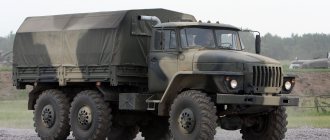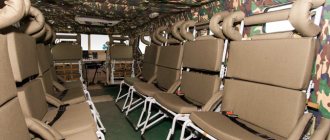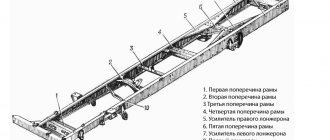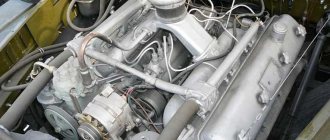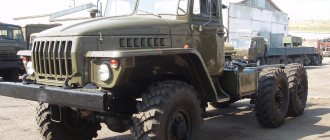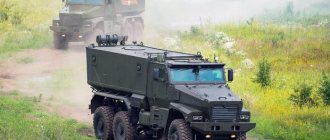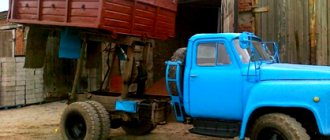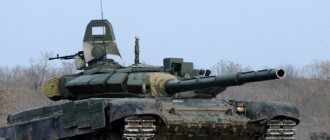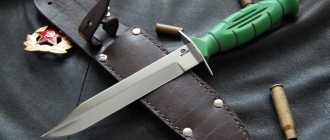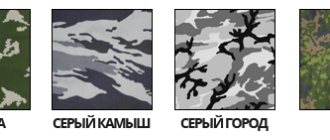The truck produced by the Ural Automobile Plant has a universal purpose. It is designed both for transporting people and for transporting goods. The performance characteristics of the Ural-4320 allow you to overcome impassable areas when fully loaded. This factor contributed to the widespread use of the vehicle in the army and in regions with difficult climatic conditions. The first model of the vehicle in question was released in 1977. In fact, the car is an improved copy of the Ural-375 car, which was produced for military needs.
Exterior
According to the performance characteristics of the Ural-4320, it is equipped with a metal platform body and a tailgate. The car is equipped with benches, an awning and removable arches. There are also additional lattice sides. The standard equipment includes a three-seat cabin, assembled from thick-walled sheet metal, manufactured by stamping. Thoughtful glazing and rear-view mirrors make it possible to fully monitor the situation on the road and increase visibility.
Structurally, the body is made in the form of short overhangs, which improves cross-country ability. The curb weight of the truck is 8.2 tons. The weight of the transported cargo is up to 67.8 tons with the ability to tow 11 tons.
TTX "Ural-4320" military with YaMZ engine
One of the variations of the power plants on the truck in question was the YaMZ engine in various modifications. It is a four-stroke engine with an electric torch device for starting. A special feature of the power unit is that before the final completion of work, it must idle for a couple of minutes.
The motor fully meets European standards (Euro-3). The capacity of the fuel tank is about three hundred liters (some models are equipped with additional 60 liter tanks). Diesel fuel consumption per hundred kilometers ranges from 30 to 40 liters, depending on the speed of movement and the presence of a tow hitch. The maximum speed of the car is 85 kilometers per hour.
History of the Urals 4320
Mass production of Ural 4320 vehicles started in November 1977. Unlike its predecessor Ural 375, this model has:
- the gasoline carburetor engine, which consumes up to 70 liters of fuel per 100 km, was replaced by a diesel engine;
- a more functional gearbox is installed;
- The power unit has been improved.
After 10 years, the total number of units produced exceeded the 1 million mark, which was due to strong demand from the Ministry of Defense and domestic oil and gas industry enterprises, constant exports. In the fall of 2015, instead of the Ural 4320, the Ural Next appeared on the freight transport market with a large number of modernized units and components. However, the 4320 model is still exported to other countries.
Other powertrain options
When developing the performance characteristics of the Ural-4320 engine, manufacturers provided for the possibility of installing several types of motors. Among them are the following variations:
- The KamAZ-740.10 installation – with a power of 230 horsepower, a volume of 10.85 liters, has 8 cylinders, operates on diesel fuel;
- YaMZ-226 – runs on diesel fuel, power is 180 horses;
- YaMZ-236 HE2 has a volume of 11.15 liters, a power of 230 horses, turbocharging, four strokes;
- In addition, modifications of the Yaroslavl Motor Plant with indices 238-M2, 236-BE2, 7601 were installed. They differ in horsepower (240, 250 and 300, respectively).
In addition, the performance characteristics of the Ural-4320 with a YaMZ engine provide for the installation of a hydraulic booster, pre-heating and compliance of the engine with the Euro 3 standard.
Characteristics
The Ural 4320 has a full range of parameters that make it an impeccable hard-working SUV.
Table 2 - Technical characteristics of Ural 4320
| engine's type | First, the diesel KamAZ740 V-shaped four-stroke. Then V-shaped four-stroke YaMZ 236 and YaMZ 238. |
| Number of cylinders | 8 (6 for YaMZ 236) |
| type of drive | All-wheel drive |
| Transmission | 5-speed |
| Synchronizers | In 2 3 4 5 gears |
| Transfer case | Two-stage |
| Wheel formula | 6 x 6 |
| Busbar type | Single-pitch |
| Front and rear overhangs | Short ones are placed high |
| Body | All metal |
| Power steering | Eat |
| Number of doors | 2 |
The Ural 4320 engine, which was first produced at Kamaz, began to be produced at the Yaroslavl Motor Plant in the 90s, the cause of which was a fire at Kamaz. The clutch of the Ural 4320 car belongs to the KamAZ-14 modification.
Maz 5336: technical characteristics, features and device (photo, video, price).
Full description of the Maz 5551 car on this page.
You will find out why it is so profitable to choose Hyundai Porter here.
Technical indicators
The brake assembly includes a main dual-circuit system and a spare single-circuit unit. The additional brake is driven by a pneumatic drive from the exhaust gases. This mechanical type unit with a drum placed on the transfer case (TC) is very effective. The parking brake is a drum brake, mounted on the output shaft of the brake valve.
The performance characteristics of the Ural-4320 are designed for a 6*6 wheel arrangement. High cross-country ability is ensured by single-pitch wheels equipped with automatic inflation of air chambers. The front suspension is dependent, has shock absorbers and semi-elliptical springs. The rear assembly is also of a dependent type with springs and reaction bars. The truck in question has three axles, all of them are driven, the front wheels are equipped with CV joints. The clutch unit has a friction drive, a pneumatic booster, and a disk with a diaphragm extension spring.
Technical characteristics of the Ural 4320-31 chassis
| Dimensions | ||
| Wheelbase, mm | 3525 + 1400 | |
| Length, mm | 7588 | |
| Width, mm | 2500 | |
| Height, mm | 2805 | |
| Outer turning radius, m | 11,6 | |
| Installation length of the frame for placing equipment, mm | 4255 | |
| Weight characteristics | ||
| Load capacity, kg | 6855 | |
| Chassis curb weight distribution, kg | to the front axle | 4550 |
| on the rear trolley | 3500 | |
| Permissible total vehicle weight, kg | 15205 | |
| Distribution of total vehicle weight, kg | to the front axle | 4635 |
| on the rear trolley | 10570 | |
| Weight of towed trailer, kg | 11500* / 7000 | |
| Engine | ||
| Engine | YaMZ-238M2 | |
| Rated engine power, kW (hp) | 176 (240) | |
| Maximum torque, Nm (kgfm) | 883 (90) | |
| Engine displacement, l | 14,86 | |
| engine's type | diesel | |
| Number and arrangement of cylinders | V8 | |
| Environmental Compliance | Euro 0 | |
| Suspension | ||
| Front suspension | dependent on two longitudinal semi-elliptical springs, working in conjunction with double-acting hydraulic telescopic shock absorbers | |
| Rear suspension | dependent on two semi-elliptic springs and suspensions, working in conjunction with double-acting hydraulic telescopic shock absorbers | |
| Transmission | ||
| Transmission | YaMZ-236U, mechanical, 5 speed. | |
| Transfer case | mechanical, two-stage with lockable center differential | |
| Tires | ||
| Tire size | 390/95R20 147J mod. O-65 or 14.00-20 146G mod. OI-25 or 12.00R20 mod. U-4,ID-304 | |
| General characteristics | ||
| Cabin | 2-door | |
| Number of seats in the cabin, including the driver's seat | 3 | |
| On-board power supply voltage, V | 24 | |
| Fuel tank capacity, l | 287 + 60 | |
| Wheel formula | 6×6.1 | |
| Fuel consumption | ||
| Control fuel consumption at a speed of 60 km/h, l/100 km | 35 | |
| Speed | ||
| Maximum speed at full vehicle weight, km/h | at I main gear = 6.7 | 85 |
| at I main gear = 7.32 | 82 | |
Notes:
- * when used on roads of categories 1-4.
- Height dimensions are indicated for the vehicle with curb weight in transport position.
- Overall width does not include rear view mirrors.
- The control fuel consumption is not an operating norm.
- Since December 1, 2002, JSC Avtomobilny has been producing cars and chassis with engines that meet environmental standards no lower than Euro I, except for cars and chassis intended for delivery to the Ministry of Defense.
Cabin and dimensions
The presented truck is equipped with a two-door cabin, it is made entirely of metal and is designed for three people. The driver's seat is adjustable, there is a ventilation system, modernized versions are equipped with a sleeping bag. After 2009, driver working conditions have improved significantly. The new cabin has increased comfort, a fiberglass hood and an original design style.
Below are the main overall dimensions that provide for the performance characteristics of the Ural-4320:
- Length/width/height (m) – 7.36/2.5/2.71, according to the awning the height is 2.87 meters.
- Net weight (t) – 8.57.
- Maximum towbar weight (t) – 7.0.
- Wheel track (m) – 2.0.
- Ground clearance (cm) – 40.
- The number of seats on the platform is 24.
It is worth noting that the truck has a solid range, allowing it to travel hundreds of kilometers without refueling.
Tactical indicators
The military performance characteristics of the Ural-4320 have the following capabilities in tactical terms:
- Fording the reservoir (depth) is one and a half meters.
- Crossing swampy terrain is similar.
- Ditches and trenches (depth) - up to 2 meters.
- The maximum lifting height is 60°.
- The minimum turning radius is 11.4 meters.
- The maximum altitude above sea level for normal operation is 4 thousand 650 meters.
Structurally, the powerful truck is designed in such a way as to protect the cabin and driver from dirt when driving off-road (the power plant is located in the front, the hood is raised up, and wide flat fenders are installed on the sides).
The performance characteristics of the Ural-4320 allow it to be used in harsh climatic conditions with a maximum humidity of 98°. The temperature range is from + to –50 degrees. Garage-free storage of the vehicle is permitted. The maximum sustained wind force is 20 meters per second, and the dust content is 1.5 cubic meters.
Purpose of Ural 4320
The key purpose of the Ural machine is as follows:
- Passenger Transportation;
- transportation of cargo of various sizes;
- towing trailers and various special equipment.
The widespread use of the machine is due to the ability to move on any surface, including off-road (on rough terrain). The latter property is ensured by powerful diesel engines, a 6x6 wheel arrangement and impressive ground clearance.
The basic Ural 4320 chassis was often used as the basis for the creation of:
- tilt, side-mounted vehicles of extended and standard assembly;
- rotational 30 and 22-seater buses;
- fuel tankers;
- tank trucks;
- truck tractors;
- municipal, road equipment;
- special installations for gas and oil production;
- fire trucks, etc.
The leading analogues today are: KrAZ 255B, KamAZ 4310, ZIL 131. Ural Next is an improved version. There are quite a lot of used trucks on the domestic market, so purchasing one for personal use is not difficult.
The Ural 4320 truck and its modifications have been produced and used for more than 40 years. Technical features allow you to drive where the road is closed to other cars, transport any cargo, and withstand very low and high temperatures. A high degree of safety has been tested and proven over years of active use. Based on this, this vehicle will probably remain one of the most popular cargo models on the vehicle market for a very long time.
Video: Ural 4320-0911-30
Publications on the topic
The principle of operation of the brake system of the Urals 5557, 4320
Repair and review of Ural 4320 (video selection)
Description of the device and technical characteristics of Ural-43206
Current modifications
During the production of the truck in question from Ural manufacturers, several modifications were developed, the main difference between which is the power of the power plant. The following models have become the most popular:
- "Ural-4320-01" - has an improved cabin, platform and gearbox. Year of manufacture: 1986.
- Similar modifications with a YaMZ engine with a power of 180 horses, as well as a truck with an increased wheelbase and cross-country ability.
- The performance characteristics of the Ural-4320-31 differ from its predecessor in the presence of an eight-cylinder power unit (YaMZ) with a capacity of 240 horsepower and an improved power density. The car was released in 1994.
- Model 4320-41 - YaMZ-236NE2 engine (230 hp), year of manufacture - 2002, compliance with Euro 2 standards.
- Option 4320-40 is a version of the previous car, equipped with an extended wheelbase.
- Modification 4320-44 - a cabin of improved comfort appeared (manufactured in 2009).
- Long wheelbase "Ural-4320-45".
- Variation designed for installation of special equipment (4320-48).
From the book by Kanunnikov S.V. and Shelepenkova M.A. edited by Markov N.S. "Domestic trucks". — Orel, SALON LLC, 2022. For me, this is a reference book, thanks to the authors and everyone who took part in its publication.
Ural-4320 (6×6) 1972-88, Ural-4320-01 (6×6) 1988-93, Ural-4320-10 (6×6) 1993-present,
Ural-4320-31 (6×6) 1994-present, Ural-43206 (4×4) 1995-present.
Back in the 1960s, the USSR Ministry of Automotive Industry began replacing voracious gasoline truck engines with diesel ones. One of the first experiments in this area was the installation in 1965-66 of the YaMZ-236 diesel engine on the Ural-375D, Ural-380S and Ural-377 instead of the ZIL-375 gasoline engines. The last car, built jointly with NAMI, received its own name Ural-E377D.
The first prototype of the Ural-375D with the new Yaroslavl diesel engine YaMZ-7E641 (210 hp) appeared in 1969. However, the YaMZ-7E641 engine turned out to be unsuccessful, and there was no point in adapting it to the chassis of Ural cars.
But work on dieselization of Ural vehicles did not stop. Already in 1972, prototypes of the Ural-4320 were built with a YaMZ-740 engine, which they planned to produce at the KamAZ plant. By 1974, the vehicles passed tests quite successfully, and in 1977 they began mass production in parallel with the old gasoline trucks. Externally, diesel modifications were distinguished by a radiator grille. In 1977, a floating version of a diesel car, the Ural-4320P, was briefly tested.
In the mid-1980s, experiments were carried out to adapt the air-cooled Ural-744.10 diesel engine to the Ural-4320. A prototype of such a machine carried the index Ural-4320V, and the prototypes were designated Ural-43205.
Since 1988, they produced the modernized Ural-4320-01, the main external difference of which was the installation of an on-board platform without protruding wheel wells inside the body.
After the fire at the Kamaz engine plant, Yaroslavl diesel engines began to be installed on cars: from 1993 - YaMZ-236M2 for the Ural-4320-10 version (V6; 11.15 l; 180 hp) and from 1994 - YaMZ- 238M2 to Ural-4320-31 (V8; 14.86 l; 240 hp). A characteristic difference between these machines was the external location of the air filter housing on the right wing of the cabin. In addition, modifications with a V8 engine had a longer hood (later, for the sake of unification, versions with V6 engines began to be equipped with the same).
By order of the border guards, a lighter two-axle Ural-43206 was created on the basis of the three-axle Ural-4320-10 model. It was planned that it would replace the outdated GAZ-66. It was initially certified in October 1995 as Ural-4325, but then, at the request of NAMI, it was renamed and from January 1996 it was produced under the new designation Ural-43206.
The Ural-4320 series vehicles are still produced in a modernized form, including those with cabover cabs.
Modifications of Ural-4320-31:
Ural-4320-0911-30 - flatbed truck with a carrying capacity of 10 tons with an extended wheelbase and wide-profile tires;
Ural-432006-0911-30 - flatbed truck with an extended wheelbase and wide-profile tires in export version;
Ural-432007-0911-30 - flatbed truck with an extended wheelbase and wide-profile tires in an export tropical version;
Ural-4320-0917-30 - a long-wheelbase truck with a special platform for transporting long pontoons;
Ural-432006-0917-30 - a long-wheelbase truck in export version with a special platform for transporting long pontoons;
Ural-432007-0917-30 - a long-wheelbase truck in an export tropical version with a special platform for transporting long pontoons;
Ural-4320-1810-30 - chassis with an extended wheelbase and wide-profile tires;
Ural-4320-1911-30 - chassis with an extended base and wide-profile tires for installing drilling equipment;
Ural-432006-1911-30 - chassis with an extended base and wide-profile tires in export version for installation of drilling equipment;
Ural-432007-1911-30 - chassis with an extended base and wide-profile tires in an export tropical version for installing drilling equipment;
Ural-432006-31 - flatbed truck in export version (1994); Ural-432007-31 - flatbed truck in export tropical version (1994);
Ural-4320-0710-31 - flatbed truck-tractor for towing trailers weighing up to 8.5 tons;
Ural-4320-1011-31 - chassis for van bodies;
Ural-432006-1011-31 - chassis in export version for van bodies;
Ural-432007-1011-31 - chassis in export tropical version for van bodies; Ural-4320-1012-31 - chassis for installing special bodies;
Ural-432006-1012-31 - chassis in export version for installation of special bodies; Ural-432007-1012-31 - chassis in export tropical version for installation of special bodies; Ural-4320-1712-31 - chassis for van bodies;
Ural-43202-31 - version with an onboard platform and wide-profile tires,
Ural-432026-31 - export version of Ural-43202-31;
Ural-432027-31 - version of Ural-43202-31 in export tropical version;
Ural-43202-1012-31 - chassis for installing special bodies;
Ural-432026-1012-31 - chassis in export version for installation of special bodies; Ural-432027-1012-31 - chassis in export tropical version for installation of special bodies;
Ural-43203-31 - chassis for van bodies;
Ural-43204-31 - timber carrier;
Ural-432046-31 - timber carrier in export version; Ural-432047-31 - timber carrier in export tropical version;
Ural-43204-1111-31 - timber truck chassis; Ural-432046-1111 -31 - timber truck chassis in export version;
Ural-432047-1111 -31 - timber truck chassis in export tropical version;
Ural-4420-31 - truck tractor based on the Ural-4320-31;
Ural-442006-31 - truck tractor in export version based on Ural-432006-31;
Ural-442007-31 - a truck tractor in an export tropical version based on the Ural-432007-31;
Ural-44201-31 - truck tractor for an active semi-trailer based on the Ural-4320-31;
Ural-44202-31 - truck tractor based on Ural-43202-31;
Ural-442026-31 - truck tractor in export version based on Ural-432026-31;
Ural-442027-31 - a truck tractor in an export tropical version based on the Ural-432027-31;
Ural-5557-0210-31 - agricultural dump truck;
Ural-555706-0210-31 - agricultural dump truck in export version;
Ural-555707-0210-31 - agricultural dump truck in export tropical version;
Ural-5557-1052-31 - agricultural dump truck chassis;
Ural-555706-1052-31 - agricultural dump truck chassis in export version;
Ural-555707-1052-31 - agricultural dump truck chassis in export tropical version; Ural-55571-0021-30 - construction dump truck;
Ural-555716-0021-30 - construction dump truck in export version;
Ural-555717-0021 -30 - construction dump truck in export tropical version; Ural-55571-1021-30 - construction dump truck chassis;
Ural-555716-1021-30 - construction dump truck chassis in export version;
Ural-555717-1021-30 is a construction dump truck chassis in an export tropical version.

